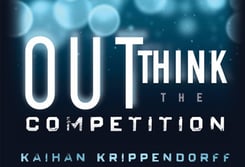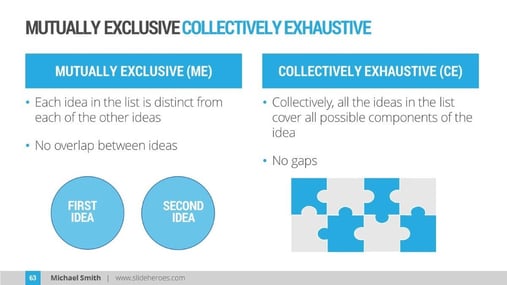 We’ve been sharing ideas and concepts from Outthink the Competition: How a New Generation of Strategists Sees Options Others Ignore by Kaihan Krippendorff.
We’ve been sharing ideas and concepts from Outthink the Competition: How a New Generation of Strategists Sees Options Others Ignore by Kaihan Krippendorff.
Great armies, athletes, and companies win by seeing new strategic options that adversaries are unable to respond intelligently to. You need not think like an Outthinker to survive. You can work harder and move faster within the old paradigm, but this is like rowing more forcefully while your neighbor has put up a sail. The thinkers will continue row, make progress, but in the end, Outthinkers will sail past effortlessly, going with the flow and adjusting to the new paradigm.
Revolutions (Innovation) in business, sports, and military all follow the Very Same Pattern
- People grow rigid: they accept that a certain way of doing things (Krippendorff calls this the 1-2-3) is the best and stop seeking better options.
- Someone questions what others have accepted and finds a new strategy (Krippendorff call this the fourth option).
- The new strategy proves superior.
- The competition tries to copy it but can only do so slowly.
There are four challenges, then, to Outthink your competition:
- You must first recognize where rigidity has taken hold.
- You must then find a new strategic option (a fourth option) that others ignore.
- You must figure out whether this new strategy is superior.
- You must slow your competitors' ability to copy your innovation.
The winds have shifted. A new generation of Outthinkers has emerged. You need to learn how to put down your oar and put up your sail.
NEW ORDER
There is nothing more difficult to take in hand, more perilous to conduct, than to take a lead in the introduction of a new order of things, because the innovation has enemies, all those who have done well under the old conditions and lukewarm defenders in those who may do well under the new.
In a webinar, yesterday, The 4 Steps to Transform Your Leadership Team and Accelerate Business with Salim Ismail, author of The Exponential Organization, founding executive director of Singularity University, Salim suggested you can’t reach disruptive measures yourself. You need outside help.
Why?
Because in your industry you will naturally resist change. You will either dismiss or reduce the ideas suggested. Salim sees an immune system that surrounds businesses to resists change. Disruptive Ideas are naturally difficult to see. People within the business itself fail to recognize their value.
Krippendorff, on the other hand, has trained several thousand people in the process, from employees at companies such as Microsoft, General Electric, L'Oreal, Johnson & Johnson, Symantec, and Walmart, as well as a long roster of fast-growing mid-market companies.
Krippendorff began applying a version of his process at Microsoft about five years ago. At the time, many thought Microsoft was losing its innovative edge. Krippendorff and his colleagues worked with several hundred of Microsoft's emerging high-potential leaders each year. Managers who really embraced the Outthinker Process experienced a shift in how they worked together. They are more comfortable exploring crazy ideas, less likely to immediately kill off ideas that may seem unorthodox, and more effectively share these ideas with colleagues in the company. Krippendorff is beginning to see real evidence some forward-looking strategic choices are starting to pay off with new devices, acquisitions, and strategic moves.
Mutually Exclusive, Collectively Exhaustive (MECE) Components
At McKinsey & Company, Krippendorff was trained through constant repetition to break problems down into mutually exclusive, collectively exhaustive (MECE) components.
This exercise has two goals:
- To help your team to expand its point of view and thereby begin seeing new leverage points that your competition is overlooking and
- To find an opportunity to narrow the scope of the problem, focusing on the parts with the potential to generate the greatest return on your effort.
Analyze the System
To help you and your team to see the big picture and identify points of leverage or variables others overlook, it helps to build a systems map. First, restate, in summarized form, your near-term ideal in a small box in the middle of a piece of paper. Then ask yourself what needs to be true for you to achieve this near-term ideal.
The Exercise
To build your systems map, gather your team around a flip chart or large piece of paper. Use markers or, even better, Post-it notes, and begin the process here:
- Restate your strategic question, writing it in a small square at the center of the page. For the Tesla case, for example, participants took the strategic question, “How do we help double the number of electric vehicles sold in the world and ensure that 80 percent of them use Tesla technology in three years?” and rewrote it in shortened form: “Double EVs sold and 80 percent share?”
- Define your primary issues or drivers. Just as a war is won by winning multiple battles, you realize your near-term ideal likely will require you to solve multiple issues. Define these by asking yourself, “What must be true for us to achieve this near-term ideal?” or “What are the issues that we have to consider to fully address our strategic question?” Write each primary variable in a small square around the strategic question and use arrows to connect each to your near-term ideal and indicate the direction of influence. For the Tesla case, participants might break down the problem into three pieces: technology, cars, and drivers. The rationale for this breakdown is that as long we can get our technology into enough EV cars and get drivers to buy them, we can double EVs sold and achieve an 80 percent share.
- Selectively expand the map. Pick one primary issue you want your team to attack. If you already have a solution for that issue, leave it untouched on the map. If it calls out to you as something that appears particularly important and difficult to solve, it is probably worth spending time to further dissect it. Continue expanding your systems map until you have achieved an insight, that is, until you have identified a new leverage point that you had not considered before, or you recognize one pivotal issue that, if resolved, would substantially solve your problem. Narrow the scope of your work onto that issue. In our experience, a useful systems map has approximately 5 to 15 boxes.
- Decide which key issue(s) to address now. Finally, you want to select one to three key issues that you think your team should work on immediately. You will not have time to address all the issues in one day, so you want to focus creative energy on those drivers that will move you most rapidly toward a solution. Write those key issues in the form of questions on the right-hand side. Participants working on the Tesla case might decide in the end to focus on finding a creative way to reduce the erratic fluctuations of oil prices (because when oil prices fall, an electric vehicle becomes a more expensive option) and winning over key partners to establish Tesla as the “must have” technology.
NEXT BLOG
This is the first step in the process to Outthink Your Competition. There are two more steps including separating your ideas into four quadrants to map every idea you create to find a way to win with the least amount of effort and to find the path of greatest ease. Next blog we’ll look at ground rules, roles, and examine the stratagem from the book to determine your best direction to pursue.
If you’d like help with this or any of the Scaling Up principles to grow your business, contact me at dwick@positioningsystems.com.






.jpeg?width=150&height=135&name=Hand%20with%20marker%20writing%20the%20question%20Whats%20Next_%20(1).jpeg)

